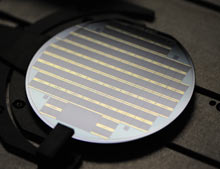New Materials Make Photovoltaics Better
A startup called Solar Junction says its pilot manufacturing plant is producing solar cells units that are more efficient than the best ones on the market today. The advance, based on new semiconductor materials that the company has developed, could help make a type of solar power system called concentrated photovoltaics a far more attractive way to generate electricity from the sun.

Concentrated photovoltaic systems account for a small fraction of total solar power today—with only several megawatts of production capacity installed, compared to many gigawatts of capacity for conventional solar panels. They’re limited to very sunny areas, where they compete with solar thermal, the cheapest form of solar power today, which uses mirrors to concentrate sunlight for the purpose of generating steam for steam turbines. Advances in solar cell efficiency have only recently made concentrated photovoltaic systems economical in some areas.
Craig Stauffer, cofounder of Solar Junction, based in San Jose, California, says his company’s new cells could bring the price of solar power to below 10 cents per kilowatt hour, compared to 16.5 cents per kilowatt hour or more for typical solar panels. Solar Junction’s cells require fewer layers than many other ultra-efficient solar cells and are better matched to the solar spectrum.
Solar Junction’s cells are designed for photovoltaic systems that use mirrors or lenses to concentrate sunlight 1,000 times. Concentrating sunlight improves the efficiency of most solar cells, but solar cells designed for use under such high concentrations—called multi-junction cells–do particularly well because they incorporate two or three semiconductor layers for absorbing different colors of sunlight, rather than the single semiconductor layer used in conventional solar panels.
Concentrated solar power has been held back by the difficulty of finding semiconductors that divide up the spectrum in the optimal way, but that also have matching crystalline structures, which makes the cells easy to fabricate. Solar Junction’s technology tackles the problem for the infrared end of the spectrum, the part that’s proven the most challenging for multi-junction cell developers. In conventional multi-junction cells semiconductor materials designed for this part of the spectrum either absorb light that’s too far into the infrared or aren’t compatible with the other semiconductors in the cell, and so require costly buffer layers.
Stauffer says that his company’s new materials have neither of those problems. He isn’t disclosing details about what the materials are made of, but he says that their crystalline structure is compatible with other semiconductor materials used in multi-junction cells, and they can be modified to absorb different wavelengths to optimize efficiency. (The company calls them Adjustable Spectrum Lattice Matched materials).
The new cells, which use one of the new materials, convert 41 percent of the energy in sunlight into electricity, compared to 38 to 39 percent for other multi-junction cells on the market. (World record efficiencies are higher than this, but researchers have achieved such levels with one-off cells made in the lab, not on a production line.) A jump of two percentage points can make a big difference in the price of solar systems, especially with concentrated photovoltaics, where only about 20 percent of the cost is the cells. Increasing power output from the cells reduces the number of lenses, metal frames, tracking systems, and other components that account for 80 percent of costs.
Stauffer says that the company has also made two more novel semiconductors that, when added to future cells, could bring efficiencies up to 50 percent. Because the materials can all be easily grown on top of each other, these five-layer devices can be made for the same cost as three-layer devices. He anticipates that the company can produce such cells within five years.
“I wouldn’t be surprised if they get to 50 percent, but the question is when, and how much they will cost,” says Jerry Olson, a principal scientist at the National Renewable Energy Laboratory in Golden, Colorado. He says that the implementation will likely take longer than the company thinks, since the solar cells are complex.
Even at less than 10 cents per kilowatt hour, concentrated photovoltaics will still produce power at rates that are far more expensive than fossil fuel power, which often costs less than six cents per kilowatt hour, and has the considerable advantage of working day and night. Olson says that while concentrated photovoltaics are still relatively uncommon, they have the potential to be the cheapest type of solar photovoltaics, because high concentrations of sunlight reduce both the amount of land and expensive semiconductor material needed.
Keep Reading
Most Popular
Large language models can do jaw-dropping things. But nobody knows exactly why.
And that's a problem. Figuring it out is one of the biggest scientific puzzles of our time and a crucial step towards controlling more powerful future models.
The problem with plug-in hybrids? Their drivers.
Plug-in hybrids are often sold as a transition to EVs, but new data from Europe shows we’re still underestimating the emissions they produce.
Google DeepMind’s new generative model makes Super Mario–like games from scratch
Genie learns how to control games by watching hours and hours of video. It could help train next-gen robots too.
How scientists traced a mysterious covid case back to six toilets
When wastewater surveillance turns into a hunt for a single infected individual, the ethics get tricky.
Stay connected
Get the latest updates from
MIT Technology Review
Discover special offers, top stories, upcoming events, and more.